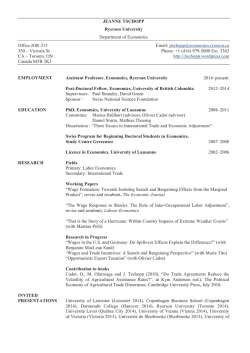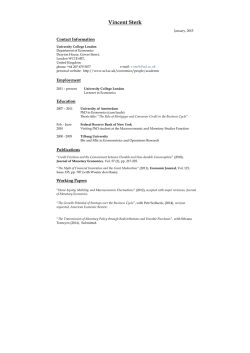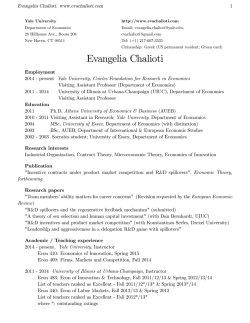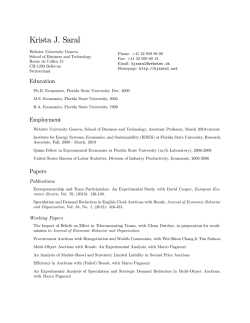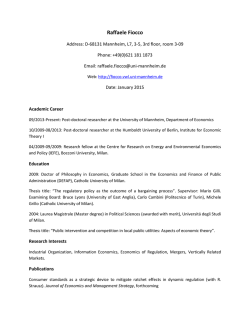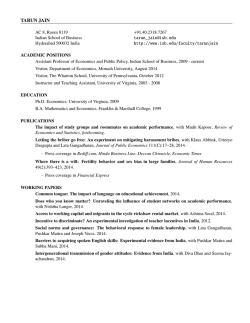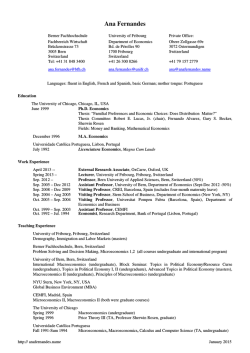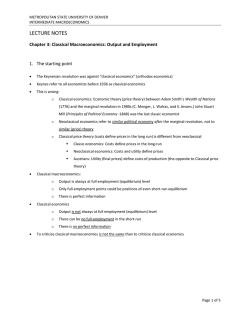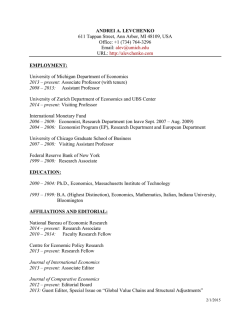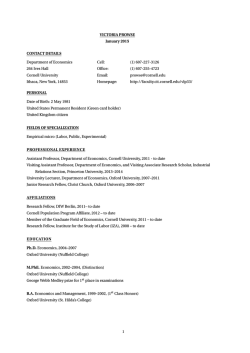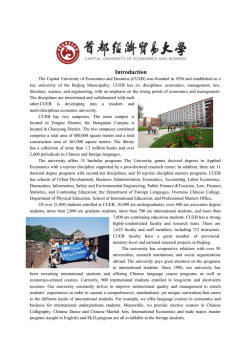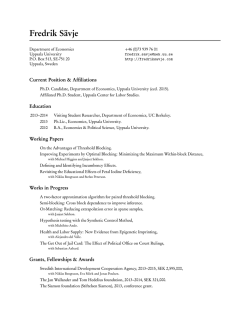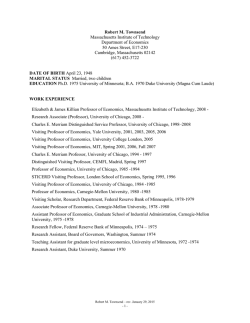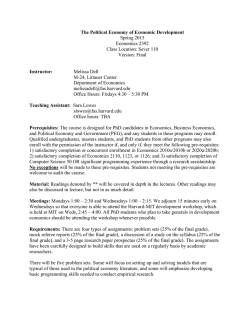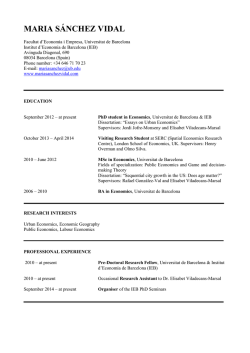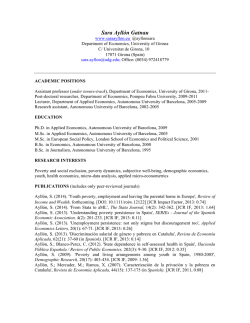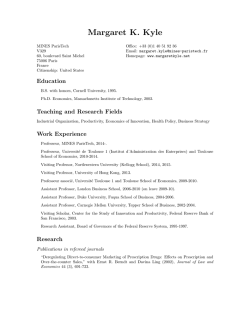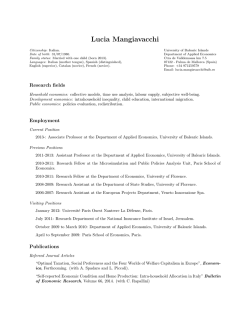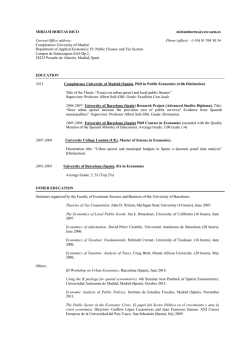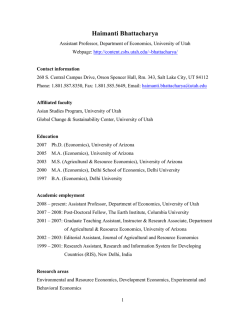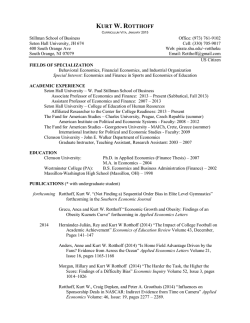
Topics in the Economics of Gender
Department of Economics Boston College EC 302: Topics in the Economics of Gender Spring 2015 Instructor: Professor S Anukriti Email: [email protected] Of:ice: Maloney 329 Phone: (617) 552-‐1570 Of:ice Hours: Email for appointment Lectures: Tuesdays and Thursdays, 10:30 am – 11:45 am (O'Neill 257) Description: This course examines gender disparities through an economic lens. We will explore potential explanations for these differences in the context of both developed and developing countries, and consider the role for policy interventions in each context. Pre-‐requisites: Intermediate Microeconomics and Econometric Methods. Course Website: All course-‐related materials will be posted on Canvas. Requirements and Grading: Students are expected to actively participate in classroom discussions. There is no :inal exam. The :inal grade will be based on: • • • • • A group presentation (10%): We will divide the class into 5 groups. Each group will be assigned a popular book on gender and will make a 30-‐35 min presentation to the class on Apr 23 or Apr 28 or Apr 30. A presentation on a $ paper in the reading list (15%): These presentations should be ~20 min long and will take place throughout the semester. Two problem sets (10% each): The problem sets will be posted on Jan 29 and Apr 2 and the respective due dates are Feb 10 and Apr 16. A 4-‐5 page review of an academic paper (15%): The due date is Mar 10 (before midnight). A 10-‐15 page paper (40%): The due date is May 5 (before midnight). More details about the papers and presentations will be provided in class. Books for Group Presentations: Kristof, Nicholas D. and Sheryl WuDunn (2010), Half the Sky: Turning Oppression into Opportunity for Women Worldwide, Vintage Hvistendahl, Mara (2012), Unnatural Selection: Choosing Boys Over Girls, and the Consequences of a World Full of Men, PublicAffairs Collins, Gail (2009), When Everything Changed: The Amazing Journey of American Women from 1960 to the Present, Little, Brown and Company Sandberg, Sheryl (2013), Lean In: Women, Work, and the Will to Lead, Knopf Babcock, Linda and Sara Laschever (2003), Women Don't Ask: Negotiation and the Gender Divide, Princeton University Press Notes: • • • • • If you are a student with a documented disability seeking reasonable accommodations in this course, please contact Kathy Duggan, (617) 552-‐8093, [email protected], at the Connors Family Learning Center regarding learning disabilities and ADHD, or Paulette Durrett, (617) 552-‐3470, [email protected], in the Disability Services Of:ice regarding all other types of disabilities, including temporary disabilities. Advance notice and appropriate documentation are required for accommodations. I will try to respond to all course-‐related emails within 24 hours. However, please do not expect any response over the weekend (Sat and Sun). Before sending me an email, make sure that the information you need is not available on Canvas. Late assignments will not be accepted, irrespective of the reason. All questions about your grade on an assignment must be presented in writing over email within one week of its return. In response, I will re-‐grade the entire assignment which might result in a lower grade than the original. Reading List: There is no textbook for this course. Readings marked with a $ will be used for classroom presentations by students. 1. Introduction Doepke, Matthias, Michèle Tertlit, and Alessandra Voena (2012), “The Economics and Politics of Women’s Rights,” The Annual Review of Economics, 4, 339-‐372 Du:lo, Esther (2012), "Women Empowerment and Economic Development," Journal of Economic Literature, 50 (4), 1051-‐79 Blau, Francine (1998), “Trends in the Well-‐being of American Women: 1970-‐1995,” Journal of Economic Literature, 36 (1), 112-‐165 Goldin, Claudia (2006), “The Quiet Revolution that Transformed Women’s Employment, Education, and Family,” American Economic Review Papers and Proceedings, 5, 1-‐21 Goldin, Claudia, Lawrence F. Katz, and Ilyana Kuziemko (2006), “The Homecoming of American College Women: The Reversal of the Gender Gap in College,” Journal of Economic Perspectives, 20, 133-‐156 Alesina, Alberto, Paola Giuliano, and Nathan Nunn (2011), “On the Origins of Gender Roles: Women and the Plough,” Quarterly Journal of Economics, 128 (2), 469-‐530 Rosin, Hanna (2010), New data on the rise of women, TED Talk 2. Gender and Behavior Niederle, Muriel (2014), “Gender,” NBER Working Paper No. 20788 $ Andreoni, James and Lise Vesterlund (2001), “Which is the Fair Sex? Gender Differences in Altruism,” Quarterly Journal of Economics, 116 (2), 293-‐312 Gneezy, Uri, Muriel Niederle, and Aldo Rustichini (2003), “Performance in Competitive Environments: Gender Differences”, Quarterly Journal of Economics, 118 (3), 1049-‐74 Niederle, Muriel and Lise Vesterlund (2007), “Do Women Shy Away from Competition? Do Men Compete Too Much?,” Quarterly Journal of Economics, 122 (3), 1067-‐1101 Niederle, Muriel and Lise Vesterlund (2010), “Explaining the Gender Gap in Math Test Scores: The Role of Competition,” Journal of Economic Perspectives, 24 (2), 129-‐144 $ Castillo, Marco, Ragan Petrie, Maximo Torero, and Lise Vesterlund (2011), “Gender Differences in Bargaining Outcomes: A Field Experiment on Discrimination,” Journal of Public Economics, 99, 35-‐48 3. Patriarchy and Matrilineality $ Andersen, Steffen, Erwin Bulte, Uri Gneezy, and John A. List (2008), “Do Women Supply more Public Goods than Men? Preliminary Experimental Evidence from Matrilineal and Patriarchal Societies,” American Economic Review Papers and Proceedings, 98 (2), 376-‐81 Gneezy, Uri, Kenneth L. Leonard, and John A. List (2009), “Gender Difference in Competition: Evidence from a Matrinineal and Patriarchal Society,” Econometrica, 77 (5), 1637-‐64 Andersen, Steffen, Seda Ertac, Gneezy, Uri, John A. List, and Sandra Maximiano (2009), “Gender, Competitiveness, and Socialization at a Young Age: Evidence From a Matrilineal and a Patriarchal Society,” Review of Economics and Statistics, 95 (4), 1438-‐43 $ Gong, Binglin and Chun-‐Lei Yang (2012), “Gender Differences in Risk Attitudes: Field Experiments on the Matrilineal Mosuo and the Patriarchal Yi,” Journal of Economic Behavior and Organization, 83 (1), 59-‐65 4. Prenatal and Postnatal Discrimination against Girls Sen, Amartya (1990), “More than 100 Million Women are Missing,” The New York Review of Books, December $ Almond, Douglas, Lena Edlund, and Kevin Milligan (2009), “Son Preference and the Persistence of Culture: Evidence from Asian Immigrants to Canada,” Population and Development Review, 39 (1), 75-‐95 Almond, Douglas and Lena Edlund (2008), “Son Biased Sex Ratios in the US 2000 Census,” Proceedings of the National Academy of Sciences of the United States of America, 105, 5681-‐82 Dubuc, Sylvie and David Coleman (2007), “An Increase in the Sex Ratio of Births to India-‐born Mothers in England and Wales: Evidence for Sex-‐Selective Abortion,” Population and Development Review, 32, 328-‐32 $ Das Gupta, Monica (1987), “Selective Discrimination Against Female Children in Rural Punjab, India,” Population and Development Review, 13, 77-‐100 Das Gupta, Monica and Li Shuzhuo (1999), “Gender Bias in China, South Korea and India 1920-‐1990: The Effects of War, Famine and Fertility Decline,” Development and Change, 30, 619-‐52 Das Gupta, Monica, Jiang Zhenghua, Li Bohua, Xie Zhenming, Woojin Chung, and Bae Hwa-‐Ok (2003), “Why is Son Preference So Persistent in East and South Asia? A Cross-‐country Study of China, India and the Republic of Korea,” Journal of Development Studies, 40, 153-‐87 $ Qian, Nancy (2008), “Missing Women and the Price of Tea in China: The Effect of Sex-‐Speci:ic Income on Sex Imbalance,” Quarterly Journal of Economics, 123 (3), 1251-‐85 Jayachandran, Seema and Ilyana Kuziemko (2011), “Why Do Mothers Breastfeed Girls Less Than Boys: Evidence and Implications for Child Health in India,” Quarterly Journal of Economics, 126 (3), 1485-‐1538 Chung, Woojin and Monica Das Gupta (2007), “The Decline of Son Preference in South Korea: The Roles of Development and Public Policy,” Population and Development Review, 33, 757-‐83 $ Dahl, G. B. and E. Moretti (2008): “The Demand for Sons,” Review of Economic Studies, 75, 1085–1120 5. Marriage, Divorce, and Intra-‐Household Bargaining Stevenson, Betsey and Justin Wolfers (2007), “Marriage and Divorce: Changes and their Driving Forces,” Journal of Economic Perspectives, 21 (2), 27-‐52 Lundberg, Shelley and Robert Pollack (1996), “Bargaining and Distribution in Marriage,” Journal of Economic Perspectives, 10 (4), 139-‐58 $ Wolfers, Justin (2006), “Did Unilateral Divorce Raise Divorce Rates? A Reconciliation and New Results,” American Economic Review, 96 (5), 1802-‐20 $ Ashraf, Nava (2009), “Spousal Control and Intra-‐Household Decision Making: An Experimental Study in the Philippines,” American Economic Review, 99 (4), 1245-‐77 Anderson, Siwan (2007), “The Economics of Dowry and Brideprice," Journal of Economic Perspectives, 21 (4), 151-‐174 Ambrus, Attila, Erica Field, and Maximo Torero (2009), “Muslim Family Law, Prenuptial Agreements and The Emergence of Dowry in Bangladesh,” Quarterly Journal of Economics, 125 (3), 1349-‐97 Jacoby, Hanan G. and Ghazala Mansuri (2010), “Watta Satta: Bride Exchange and Women's Welfare in Rural Pakistan,” American Economic Review, 100 (4), 1804-‐25 Ambrus, Attila and Erica Field (2008), “Early Marriage, Age of Menarche and Female Schooling Attainment in Bangladesh, Journal of Political Economy, 116 (5), 881-‐930 $ Du:lo, Esther (2003), “Grandmothers and Granddaughters: Old-‐Age Pensions and Intra-‐household Allocation in South Africa,” World Bank Economic Review, 17 (1), 1-‐25 6. Contraception Jones, Larry E. and Michèle Tertlit (2008), “An Economic History of Fertility in the U.S.: 1826-‐1960,” in Frontiers of Family Economics, Elsevier, edited by Peter Rupert Goldin, Claudia and Lawrence F. Katz (2001), “On the Pill: Changing the Course of Women’s Education,” The Milken Institute Review: A Journal of Economic Policy, 3 $ Edlund, Lena and Cecilia Machado (2009), “Marriage and Emancipation in the Age of the Pill,” CEPR Discussion Paper No. 7485 Goldin, Claudia and Lawrence F. Katz (2002), “The Power of the Pill: Oral Contraceptives and Women’s Career and Marriage Decisions,” Journal of Political Economy, 110 (4), 730-‐70 $ Bailey, Martha J. (2006), “More Power to the Pill: The Impact of Contraceptive Freedom on Women's Life Cycle Labor Supply,” Quarterly Journal of Economics, 121 (1), 289-‐320 Bailey, Martha J. (2010), “”Momma's Got the Pill”: How Anthony Comstock and Griswold vs. Connecticut Shaped US Childbearing,” American Economic Review, 100 (1), 98-‐129 7. Women in the Labor Market Blau Francine D. and Lawrence M. Kahn (2007), “The Gender Pay Gap: Have Women Gone as Far as They Can?,” Academy of Management Perspectives, 21 (1), 7-‐23 Goldin, Claudia (1995), “The U-‐Shaped Female Labor Force Function in Economic Development and Economic History,” in Investment in Women’s Human Capital, edited by T. Paul Schultz. Goldin, Claudia and Lawrence F. Katz (2012), “The Most Egalitarian of All Professions: Pharmacy and the Evolution of a Family-‐Friendly Occupation,” NBER Working Paper No. 18410 $ Goldin, Claudia and Cecilia Rouse (2000), “Orchestrating Impartiality: The Impact of “Blind” Auditions on Female Musicians,” American Economic Review, 90 (4), 715-‐41 $ Jensen, Robert (2012), “Do Labor Market Opportunities Affect Young Women's Work and Family Decisions? Experimental Evidence from India,” Quarterly Journal of Economics, 127 (2), 753-‐92 Raquel Fernández, Alessandra Fogli, and Claudia Olivetti (2004), “Mothers and Sons: Preference Formation and Female Labor Force Dynamics,” Quarterly Journal of Economics, 119 (4),1249-‐99 8. Women and the Credit Market Deere, Carmen Diana and Cheryl R. Doss (2006), “The Gender Asset Gap: What Do We Know and Why Does it Matter?,”Feminist Economics, 12(1-‐2) De Mel, Suresh, David McKenzie, and Christopher Woodruff (2009), “Are Women More Credit Constrained? Experimental Evidence on Gender and Microenterprise Returns,” American Economic Journal: Applied Economics, 1 (3), 1-‐32 $ Field, Erica, Seema Jayachandran, and Rohini Pande (2010), “Do Traditional Institutions Constrain Female Entrepreneurship? A Field Experiment on Business Training in India,” American Economic Review, 100 (2), 125-‐ 9 9. Women and Politics UNICEF (2007), The State of The World's Children: Women and Children: The Double Dividend of Gender Equality, Chapter 4 Lott, John R. and Larry Kenny (1999), “Did Women's Suffrage Change the Size and Scope of Government?,” Journal of Political Economy, 107, 1163-‐98 $ Oswald, Andrew J. and Nattavudh Powdthavee (2010), “Daughters and Left-‐Wing Voting,” Review of Economics and Statistics, 92 (2), 213-‐27 Edlund, Lena and Rohini Pande (2002), “Why Have Women Become Left-‐Wing? The Political Gender Gap and the Decline in Marriage, Quarterly Journal of Economics, 117 (3), 917-‐61 Chattopadhyay, Raghabendra and Esther Du:lo (2004), “Women as Policy Makers: Evidence from a Randomized Policy Experiment in India,” Econometrica, 72 (5), 1409-‐43 $ Beaman, Lori, Raghabendra Chattopadhyay, Esther Du:lo, Rohini Pande, and Petia Topalova (2009), “Powerful Women: Does Exposure Reduce Bias?,” Quarterly Journal of Economics, 124 (4), 1497-‐1540 $ Beaman, Lori, Esther Du:lo, Rohini Pande, and Petia Topalova (2012), “Female Leadership Raises Aspirations and Educational Attainment for Girls: A Policy Experiment in India,” Science, 335 (6068) Gagliarducci, Stefano and M. Daniele Paserman (2012), “Gender Interactions within Hierarchies: Evidence from the Political Arena, Review of Economic Studies, 79 (3), 1021-‐52 10. Inheritance Rights Aparajita Goyal, Klaus Deininger, and Hari Nagarajan (2012), "Women's Inheritance Rights and Intergenerational Transmission of Resources in India," Journal of Human Resources, 48(1), 114-‐141 $ Roy, Sanchari (2013), “Empowering Women? Inheritance Rights, Female Education, and Dowry Payments in India” Anderson, Siwan and Garance Genicot (2012), “Suicides and Property Rights in India,” BREAD Working Paper 353 $ Rosenblum, Daniel (2015), “Unintended Consequences of Women's Inheritance Rights on Female Mortality in India,” Economic Development and Cultural Change, 63(2), 223-‐248 11. Women and Religion Meyersson, Erik (2013), “Islamic Rule and the Empowerment of the Poor and Pious,” Econometrica, 82 (1), 229-‐ 269 $ Nunn, Nathan (2013), “Gender and Missionary In:luence in Colonial Africa,” in Akyeampong E, Bates R, Nunn N, Robinson JA (eds.) African Development in Historical Perspective, Cambridge University Press (forthcoming) 12. Domestic Violence Farmer, Amy and Jill Tiefenthaler (1997), “An Economic Analysis of Domestic Violence,” Review of Social Economy, 55 (3), 337-‐58 Card, David and Gordon B. Dahl (2011), “Family Violence and Football: The Effect of Unexpected Emotional Cues on Violent Behavior,” Quarterly Journal of Economics, 126 (1), 103-‐43 Bloch, Francis, and Vijayendra Rao (2002), “Terror as a Bargaining Instrument: A Case Study of Dowry Violence in Rural India,” American Economic Review, 92 (4), 1029-‐43 $ Aizer, Anna and Pedro Dal B (2009), “Love, Hate and Murder: Commitment Devices in Violent Relationships,” Journal of Public Economics, 93 (3-‐4), 412-‐28 $ Stevenson, Betsey and Justin Wolfers (2006) “Bargaining in the Shadow of the Law: Divorce Laws and Family Distress,” Quarterly Journal of Economics,121 (1), 267-‐88 Aizer, Anna (2010), “The Gender Wage Gap and Domestic Violence,” American Economic Review, 100 (4), 1847-‐ 59 $ Chin, Yoo-‐Mi (2011), “Male Backlash, Bargaining, or Exposure Reduction? Women's Working Status and Physical Spousal Violence in India,” Journal of Population Economics, 25 (1), 175-‐200 13. Prostitution *Edlund, Lena and Evelyn Korn (2002), “A Theory of Prostitution,” Journal of Political Economy, 110, 181-‐214 Gertler, Paul, Manisha Shah, and Stefano M. Bertozzi (2005), “Risky Business: The Market for Unprotected Commercial Sex, Journal of Political Economy, 113 (3), 518-‐50 $ Arunachalam, Raj and Manisha Shah (2008), “Prostitutes and Brides?,” American Economic Review Papers and Proceedings, 98 (2), 516-‐22 Arunachalam, Raj and Manisha Shah (2013), “Compensated for Life: Sex Work and Disease Risk, Journal of Human Resources, 48, 345-‐69
© Copyright 2025
